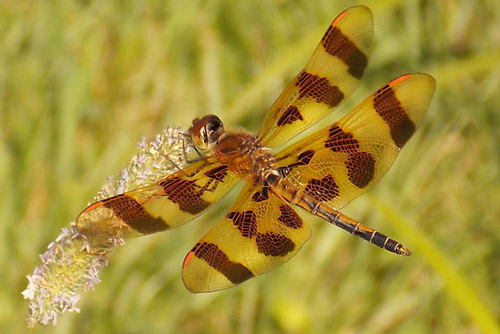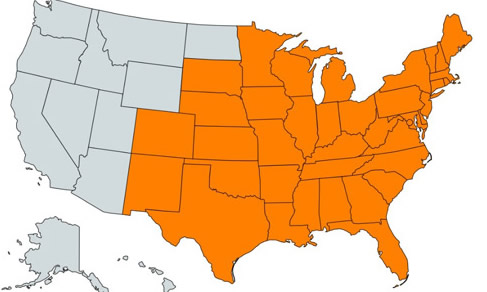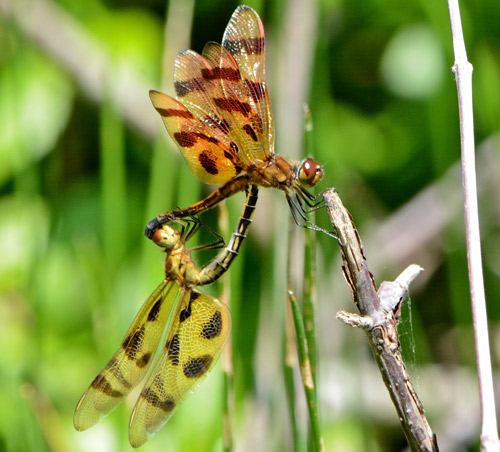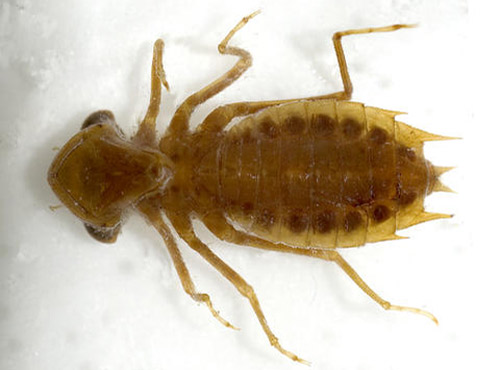common name: Halloween pennant dragonfly
scientific name: Celithemis eponina Drury (Odonata: Libellulidae)
Introduction - Distribution - Description - Life Cycle and Behavior - Selected References
Introduction (Back to Top)
Celithemis eponina Drury, the Halloween pennant dragonfly, is a brightly colored dragonfly found in the eastern United States (Figure 1). The Halloween pennant gets its name from its orange colored wings, which have dark brown bands marking them. It can often be seen perched on tips of vegetation near the edges of waterways (Taber 2005).
Figure 1. Celithemis eponina Drury, the Halloween pennant dragonfly. Photograph by Fyn Kynd.
Distribution (Back to Top)
The Halloween pennant can be found across the eastern United States, ranging from New Mexico and Colorado to the east coast, as far north as Maine (Figure 2). They can also be found in Cuba, the Bahamas, and Ontario, Canada (Dunkle 1989, NatureServe Explorer 2015). Throughout much of their U.S. range, adult Halloween pennants are seen during the summer months, but are active year round in Florida (Encyclopedia of Life 2016). Like most dragonflies, they live near bodies of water such as ponds, marshes, and lakes where they can be seen resting on emergent vegetation (Dunkle 1989, Taber 2005).
Figure 2. U.S. distribution of the Halloween pennant, Celithemis eponina Drury. Map created by Haleigh Ray, University of Florida, with http://mapchart.net/usa.html.
Description (Back to Top)
Celithemis eponina is a medium-sized dragonfly, but is considered large for the genus Celithemis (Neal and Whitcomb 1972). The adult size of Celithemis eponina ranges from 38–42 mm (1.5–1.65 inches) in length (Dunkle 1989, Taber 2005). This species has a dorsal stripe on the abdomen that may be a yellow or reddish color (Dunkle 1989). Celithemis eponina has additional markings on the body, and the colors vary by the age and sex of the individual. Females and young adult males have yellow markings, but as males mature their yellow markings redden. These yellow and red markings are found on the face, wing veins, and previously mentioned abdominal stripe (Dunkle 1989) (Figure 3).
Figure 3. Comparison of a mature male (left) and female (right) Halloween pennant, Celithemis eponina Drury. Photograph by Jessica Ware, Digital Dragonflies.
Life Cycle and Behavior (Back to Top)
Mating Behavior and Oviposition: The mating behavior of Halloween pennants is similar to that of other dragonfly species. The male will use his cerci (paired appendages on the rear segments) to grasp the female behind her head so that they are hooked together. The female will then curl her abdomen forward so that her genital opening comes into contact with the male genitalia, which are located closer to the male’s thorax than to the tip of the abdomen (Cordero-Rivera and Córdoba-Aguilar 2010). This is known as the wheel formation, as the dragonfly bodies form a closed circle (Figure 4). In a study done in south Florida, Celithemis eponina were observed mating only between 8:00 and 10:30 AM (Miller 1982, Dunkle 1989).
Figure 4. Male and female Celithemis eponina Drury mating. The male (above) is perched on a twig while the female (below) raises the tip of her abdomen to his genitalia. Photograph by Nigel Grindley, Yale University.
After copulation, the female lays eggs in water, while the male remains with the tip of the male’s abdomen attached to the female’s head (Taber 2005) (Figure 5). After the eggs are deposited, the male and female separate. The males of this species have not been documented to defend the territory around the water where they mate, contrasted to other Odonata species such as Erythemis simplicicolis (Eastern pondhawk), Libellula incesta (Slaty skimmer), and Pachydiplax longipennis (Blue dasher), which are all known to be territorial (Miller 1982, Bried and Ervin 2006).
Figure 5. A male and female Celithemis eponina Drury flying over a pond. The female has her abdomen dipped into the water as she is depositing eggs. Photograph by Van Truan.
Nymphs: Celithemis eponina nymphs are entirely aquatic, living among submerged vegetation (Figure 6). They are predacious and feed on other small aquatic arthropods, and occasionally serve as prey for fish. They develop and molt underwater and, when they are nearing adulthood, crawl out of the water onto a branch and molt a final time to emerge as adults.
Figure 6. Nymph of Celithemis eponina Drury. Photograph by Jessica Ware, WorldOdonata.
Adults: After the adults emerge from their final molt, they will take flight to locate a mate and restart the life cycle. The adults fly around above freshwater habitats and the surrounding vegetation, and feed on smaller insects that they capture in flight. Adult Celithemis eponina are very strong flyers, and can fly during rain and strong wind (Taber 2005).
Selected References (Back to Top)
- Bried JT, Ervin GN. 2006. Abundance patterns of dragonflies along a wetland buffer. Wetlands 26: 878-883.
- Cordero-Rivera A, Córdoba-Aguilar A. 2010. Selective forces propelling genitalic evolution in Odonata. In Leonard J, Córdoba-Aguilar A (Eds.) The Evolution of Primary Characters in Animals. Oxford University Press, New York, pp. 332-352.
- Dunkle SW. 1989. Dragonflies of the Florida Peninsula, Bermuda, and the Bahamas. Scientific Publishers Nature Guide. p. 127.
- Encyclopedia of Life. (2016). Celithemis eponina, Halloween pennant. (5 September 2019)
- Miller PL. 1982. Observations on the reproductive behaviour of Celithemis eponina Drury (Libellulidae, Odonata). Entomologist's Monthly Magazine 117: 209-212.
- NatureServe Explorer. (2015). Celithemis eponina. (5 September 2019).
- Neal TM, Whitcomb WH. 1972. Odonata in the Florida soybean agroecosystem. Florida Entomologist 55: 107-114.
- Taber SW. 2005. Invertebrates of Central Texas Wetlands. Texas Tech University Press. p. 56.





